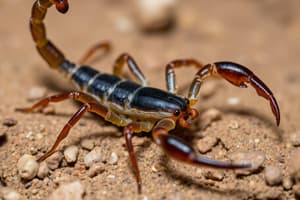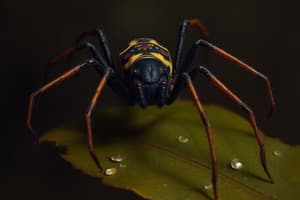Podcast
Questions and Answers
How many pairs of legs do adults, nymphs, and larvae have in the class Arachnida?
How many pairs of legs do adults, nymphs, and larvae have in the class Arachnida?
Adults and nymphs have 4 pairs; larvae have 3 pairs.
What Subphylum would the Class Arachnida be under?
What Subphylum would the Class Arachnida be under?
Chelicerata (Chelicerae)
What are some characteristics of the Order Scorpionida (Scorpions)?
What are some characteristics of the Order Scorpionida (Scorpions)?
Large pedipalps with pincers; elongated abdomen that curves over thorax with a spine and poison gland on tip.
What are some characteristics of the Order Araneida (Spiders)?
What are some characteristics of the Order Araneida (Spiders)?
What are some characteristics of the Order Acarina (Mites and Ticks)?
What are some characteristics of the Order Acarina (Mites and Ticks)?
What is the Suborder of Order Acarina?
What is the Suborder of Order Acarina?
Of the three examples from Acarina (mites, hard ticks, soft ticks), which are microscopic and which are macroscopic? (Select all that apply)
Of the three examples from Acarina (mites, hard ticks, soft ticks), which are microscopic and which are macroscopic? (Select all that apply)
What Family are Hard and Soft ticks associated with?
What Family are Hard and Soft ticks associated with?
In regards to position and visibility of mouth parts, what is known for mites, hard ticks, and soft ticks?
In regards to position and visibility of mouth parts, what is known for mites, hard ticks, and soft ticks?
In which of the three are scutums present (mites/hard/soft tick)?
In which of the three are scutums present (mites/hard/soft tick)?
Which of the three have a basis capitulum and where is it located?
Which of the three have a basis capitulum and where is it located?
What is the third tick Family and what is its significance?
What is the third tick Family and what is its significance?
What is the alternate classification of mite and tick orders based on?
What is the alternate classification of mite and tick orders based on?
Flashcards are hidden until you start studying
Study Notes
Class Arachnida Overview
- Adults and nymphs possess 4 pairs of legs, whereas larvae have 3 pairs.
- Classified under the Subphylum Chelicerata, characterized by chelicerae (mouthparts).
Order Scorpionida (Scorpions)
- Notable for large pedipalps equipped with pincers.
- Abdomen is elongated, curved over the thorax, with a spine and a poison gland at the tip.
Order Araneida (Spiders)
- Cephalothorax connects to abdomen via a narrow waist.
- Nymphs have 6 legs; adults have 8 legs.
- Chelicerae contain poison glands; some species can envenomate humans and animals.
Order Acarina (Mites and Ticks)
- Comprises arachnids of significant veterinary importance.
- Body divided into two sections: anterior gnathosoma (capitulum) and posterior idiosoma (sac-like body).
- Absent antennae, with mouthparts formed by palps, chelicerae, and hypostome.
- Eyes, if present, are very simple.
Suborder of Acarina
- Identified as Ioxida.
Microscopic vs. Macroscopic Acarina
- Mites are microscopic.
- Hard ticks and soft ticks are macroscopic.
Tick Families
- Hard ticks belong to Family Ixodidae.
- Soft ticks belong to Family Argasidae.
Mouthparts Positioning
- For mites and hard ticks, mouthparts are dorsally visible.
- Soft ticks have mouthparts that are not dorsally visible.
Scutum Presence in Ticks
- Mites and soft ticks do not have a scutum.
- Hard ticks feature a scutum, a shield structure on their back.
Basis Capitulum in Ticks
- Mites lack a basis capitulum.
- Hard ticks show a dorsally visible basis capitulum.
- Soft ticks have a ventral basis capitulum.
Third Tick Family
- Family Nuttalliellidae is noted for having only one described species (Nuttalliella namaqua), which is not extensively studied.
Alternate Classification Basis
- Classification of mites and ticks relies on the presence or absence and the location of stigmata (respiratory openings, RSO).
Studying That Suits You
Use AI to generate personalized quizzes and flashcards to suit your learning preferences.




